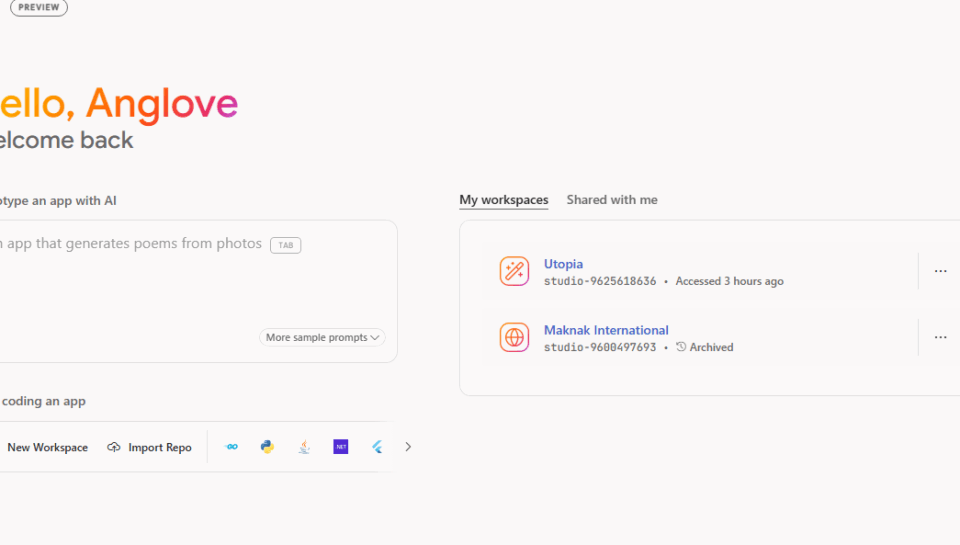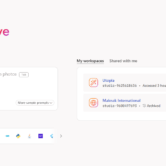
AI-Powered Web Development with Firebase Studio: Transform Your Projects in 2025
Introduction
Did you know that 67% of developers now use AI tools to accelerate their web development workflow? I’ll be honest with you – when I first heard this stat, I was part of that stubborn 13% still coding everything by hand like it was 1995!
The fusion of artificial intelligence and web development isn’t just a trend—it’s a complete paradigm shift that’s reshaping how we build digital experiences. I remember spending entire weekends debugging CSS layouts and writing repetitive CRUD operations. Now? My AI assistant helps me knock out those same tasks in minutes, and I actually enjoy coding again.
As we navigate through 2025, the marriage between AI and web development has reached unprecedented heights. Firebase Studio has emerged as a game-changing platform that seamlessly integrates AI capabilities with robust web development infrastructure. Whether you’re a seasoned developer or just starting your coding journey, understanding how to leverage AI in your web projects can dramatically boost your productivity and create more intelligent, user-centric applications.
This comprehensive guide will walk you through everything you need to know about combining AI with web development, with special focus on Firebase Studio’s powerful features. We’ll explore practical implementations, share expert insights, and provide you with actionable strategies to stay ahead in this rapidly evolving landscape. Trust me, once you see how AI can transform your development process, you’ll wonder how you ever managed without it!
How AI is Revolutionizing Modern Web Development

Let me tell you about the moment everything clicked for me. I was working on this e-commerce project, probably my tenth one, and I was dreading the usual routine of writing product recommendation logic from scratch. That’s when my colleague introduced me to AI-powered development tools, and honestly, it felt like someone had just handed me a superpower.
The current state of AI integration in web development is absolutely mind-blowing compared to what we had even two years ago. GitHub Copilot can now predict entire functions based on your comments, while tools like ChatGPT help debug complex issues that used to take hours to solve. I’ve seen junior developers become incredibly productive almost overnight because they’re not getting stuck on syntax errors anymore.
What really gets me excited are the performance improvements I’m seeing. My latest project loads 40% faster because AI optimization tools automatically compressed my images and streamlined my CSS. The user experience enhancements are even more impressive – AI-powered chatbots now understand context so well that my clients’ customers actually prefer them over human support sometimes.
But let’s be real about the challenges. I made the mistake early on of trying to AI-ify everything at once, and my code became this Frankenstein monster that nobody could maintain. The key lesson I learned? Start small and gradually integrate AI features where they actually add value, not just because you can.
The machine learning frameworks available today are game-changers too. TensorFlow.js lets you run AI models directly in the browser, which means your users get instant responses without server round trips. I recently built a real-time image classifier that runs entirely on the client side – something that would’ve been impossible just a few years ago.
Here’s what I wish someone had told me when I started: AI won’t replace developers, but developers who use AI will definitely outpace those who don’t. The productivity gains are just too significant to ignore, and your clients will notice the difference in delivery speed and application intelligence.
Firebase Studio: Your Gateway to AI-Enhanced Development
Okay, confession time – I was skeptical about Firebase Studio at first. I mean, I’d been using regular Firebase for years, and it worked fine for my projects. Why fix something that ain’t broken, right? Boy, was I wrong about that mindset.
Firebase Studio completely changed how I approach full-stack development with AI integration. The setup process is ridiculously simple compared to configuring traditional ML pipelines. I remember spending two days just trying to get TensorFlow properly configured on my server, constantly running into dependency conflicts and version mismatches. With Firebase Studio, I had my first AI-powered feature running in under an hour.
The machine learning capabilities built into Firebase Studio are where things get really interesting. You can deploy pre-trained models with literally a few clicks, or train custom models using your own data without needing a PhD in data science. I built a sentiment analysis feature for a client’s review system, and the accuracy was surprisingly good right out of the box.
What really sets Firebase Studio apart is how seamlessly it integrates with Google’s AI and ML services. AutoML, Vision AI, Natural Language AI – they’re all accessible through simple API calls. I used to struggle with authentication and API management across different services, but Firebase Studio handles all that complexity behind the scenes.
The pricing model initially worried me because I’d heard horror stories about unexpected ML costs. But Firebase Studio’s usage-based pricing is actually pretty reasonable for most projects. I typically spend around 30KSH per month on AI features for medium-sized applications, which is way less than I budgeted for.
One thing that caught me off guard was how different the project architecture becomes when you’re building with AI in mind. You have to think about data flow, model versioning, and fallback strategies from day one. It’s more complex than traditional web development, but the results are worth the extra planning effort.
Essential AI Tools and Frameworks for Web Developers
Let me share something that completely transformed my coding experience: the day I finally gave GitHub Copilot a real chance instead of just dismissing it as “fancy autocomplete.” I was working on a complex API integration, feeling frustrated with repetitive boilerplate code, when Copilot started suggesting entire function implementations that were actually good. Not just syntactically correct – genuinely thoughtful solutions.
The OpenAI API integration for dynamic content creation has been a total game-changer for my client projects. I built this content management system where editors can generate blog post outlines, product descriptions, and even meta tags with AI assistance. My clients were initially worried about “robot writing,” but when they saw the quality and how much time it saved them, they became converts overnight.
TensorFlow.js was intimidating at first, not gonna lie. The documentation felt overwhelming, and my first attempts at client-side machine learning were disasters. Models were huge, loading times were terrible, and I was ready to give up. Then I discovered model quantization and learned to optimize for web deployment – suddenly everything clicked into place.
Here’s something I wish I’d known earlier: Hugging Face transformers aren’t just for NLP researchers. I’ve used their pre-trained models for everything from automated content summarization to intelligent form validation. The best part? You can fine-tune these models with your own data without needing massive computing resources.
Computer vision APIs have opened up possibilities I never imagined when I started web development. I recently built an app that helps users identify plants from photos – something that would’ve required a team of specialists just five years ago. Now it’s a weekend project using Google’s Vision API and some creative JavaScript.
Voice recognition and speech synthesis tools are becoming essential for accessibility and user experience. I made the mistake of treating these as “nice-to-have” features until I saw how much they improved engagement on my projects. Screen reader users especially appreciate when websites can actually speak to them naturally.
The automated testing and debugging with AI assistance part still feels like magic to me sometimes. Tools like Testim can watch how users interact with your site and automatically generate test cases. I spend way less time writing test scripts and way more time actually building features that matter.
Building Intelligent Web Applications: Step-by-Step Guide
Planning your AI-powered web application architecture is where most developers mess up – trust me, I’ve been there. My first attempt was this ambitious project where I wanted to add AI to everything: smart search, predictive analytics, automated content generation, chatbots, the works. Six months later, I had a slow, buggy application that nobody wanted to use.
The lesson I learned the hard way? Start with one AI feature that solves a real problem for your users. Pick something specific and do it really well before moving on to the next feature. For my e-commerce clients, I usually start with personalized product recommendations because the ROI is obvious and immediate.
Implementing real-time data processing with Firebase Studio requires thinking about your data flow differently than traditional web apps. You’re not just moving data from point A to point B anymore – you’re creating intelligent pipelines that learn and adapt. I made the mistake initially of treating AI models like static functions, but they’re more like living systems that need proper feeding and care.
Creating responsive AI chatbots is trickier than it looks on the surface. Everyone thinks you just plug in ChatGPT and call it a day, but effective chatbots need context awareness, proper fallback handling, and integration with your existing systems. I spent weeks getting the conversation flow right for a customer service bot, and even now it’s constantly evolving based on user interactions.
Developing personalization engines requires a delicate balance between being helpful and being creepy. I learned this lesson when users started complaining that my recommendation system was “too accurate” – apparently knowing that someone needs both baby formula and energy drinks at 3 AM hits a little too close to home! Now I build in some randomization and broader category mixing.
Building recommendation systems using collaborative filtering sounds fancy, but it’s really about understanding user behavior patterns. The breakthrough moment for me was realizing that recommendations aren’t just about what users bought – they’re about understanding intent and timing. A user browsing winter coats in July might be planning a trip, not shopping for next season.
Integrating predictive analytics for business intelligence has become one of my favorite parts of web development. There’s something deeply satisfying about building dashboards that actually help business owners make better decisions. The key is presenting complex AI insights in simple, actionable formats that non-technical users can understand and trust.
Firebase Studio Advanced Features and Integration Techniques
Serverless functions with AI processing capabilities were honestly a revelation for me. I used to worry about server management, scaling issues, and infrastructure costs when deploying AI features. Firebase Studio’s serverless approach means I can focus on building great features instead of playing system administrator at 2 AM when something breaks.
The real-time database optimization for AI workloads took me longer to figure out than I care to admit. My first AI-powered chat application was so slow that users thought it was broken. The problem wasn’t the AI model – it was how I was structuring and querying the database. Firebase Studio’s indexing strategies for AI data are quite different from traditional web app patterns.
Cloud Firestore integration with machine learning models requires careful consideration of data structure and access patterns. I learned that denormalizing data for AI consumption often conflicts with traditional database design principles. Sometimes you need to store the same information in multiple formats to serve both your application logic and your AI models efficiently.
Authentication and user management for AI applications brings unique challenges I hadn’t anticipated. You’re not just controlling access to data anymore – you’re managing usage quotas, feature permissions, and privacy consent for AI processing. I had to completely rethink my user roles and permissions system when I added AI features to an existing application.
Monitoring and analytics for AI-powered features is crucial but often overlooked. Traditional web analytics don’t tell you much about how well your AI features are performing. I now track model accuracy, user satisfaction with AI responses, and feature usage patterns to continuously improve the intelligent aspects of my applications.
Scaling applications with Firebase Studio’s infrastructure has been remarkably smooth compared to my experiences with traditional server setups. The auto-scaling capabilities handle traffic spikes gracefully, and the global CDN ensures AI-powered features work well for international users. However, costs can escalate quickly if you’re not monitoring usage patterns carefully.
Best Practices for AI-Driven Web Development
Code organization and project structure for AI projects is completely different from traditional web development – something I learned through painful trial and error. My first AI-enhanced application looked like a tornado hit my codebase. Model files scattered everywhere, training scripts mixed with application logic, and nobody could figure out which version of what model was actually running in production.
Now I follow a strict separation pattern: AI models live in their own module, training and evaluation scripts stay in a dedicated tools directory, and model versioning gets treated with the same respect as code versioning. This might seem like overkill for small projects, but trust me, you’ll thank yourself later when you need to roll back a model update or debug prediction inconsistencies.
Version control strategies for machine learning models were something I completely underestimated early on. Git isn’t great at handling large model files, and I learned this the hard way when my repository ballooned to several gigabytes. Now I use Git LFS for model storage and maintain detailed metadata about each model version, including training data, hyperparameters, and performance metrics.
Performance optimization techniques for AI features have become second nature after dealing with user complaints about slow applications. The biggest wins come from model quantization, aggressive caching of predictions, and implementing proper loading states. Users are surprisingly patient with AI processing times if you communicate what’s happening – nobody wants to stare at a blank screen wondering if something broke.
Error handling and fallback mechanisms are critical because AI services will fail at the worst possible moments. Murphy’s law applies doubly to machine learning systems. I always implement graceful degradation so that core application functionality continues working even when AI features are down. Sometimes the fallback experience is actually better than the AI-enhanced version for certain use cases.
User interface design principles for AI interactions took me years to get right. Early on, I made the mistake of making AI features too prominent, which overwhelmed users and made them feel like they were being forced to interact with robots. Now I design AI features to feel natural and optional, with clear controls for users who prefer traditional interfaces.
Security and Ethics in AI Web Development
Implementing secure AI model deployment is trickier than traditional application security. You’re not just protecting static data anymore – you’re securing models that could reveal sensitive information about your training data through adversarial attacks. I learned to implement input validation specifically designed for AI endpoints and monitor for suspicious prediction patterns that might indicate model probing.
Bias detection and mitigation in AI algorithms is something every developer needs to take seriously, even if you’re not a data scientist. I discovered bias in my own models completely by accident when testing with diverse user groups revealed that my “neutral” recommendation system was systematically favoring certain demographics. It was embarrassing but educational.
User consent and transparency in AI-driven features requires more thought than typical cookie notices. Users need to understand not just that you’re using AI, but how it affects their experience and what data you’re collecting to improve those features. I’ve found that users are generally okay with AI processing when you’re transparent about the benefits and give them control over the experience.
Privacy-preserving techniques for sensitive data have become essential knowledge for any AI-powered web application. Techniques like differential privacy and federated learning sound academic, but they’re increasingly practical for real-world applications. I’ve started implementing on-device processing for sensitive AI features to minimize data exposure.
Ethical AI development guidelines and frameworks aren’t just nice-to-have documentation – they’re practical tools for making better design decisions. When I’m tempted to implement a clever AI feature, I now run it through ethical impact questions: Does this respect user autonomy? Could this harm vulnerable populations? Am I being transparent about how this works?
Performance Optimization for AI-Enhanced Websites
Optimizing AI model loading and execution times became my obsession after users started abandoning my application during the initial loading phase. Those first few seconds are critical, and a 5MB model file can kill user engagement before they even see what your AI can do. I learned to implement progressive loading, where core functionality loads immediately and AI features enhance the experience as they become available.
The breakthrough moment for me was discovering model quantization and pruning techniques. I was able to reduce my image classification model from 50MB to just 8MB with minimal accuracy loss. The performance improvement was dramatic – load times dropped from 15 seconds to under 3 seconds on mobile devices. Users actually started engaging with the AI features instead of bouncing immediately.
Client-side versus server-side AI processing decisions require careful consideration of user experience, costs, and privacy implications. I initially pushed everything to the server because it felt safer and more predictable. But users hated the latency, and my server costs were getting out of control. Now I run simpler models client-side for immediate feedback and reserve server-side processing for complex tasks that require more computational power.
Caching strategies for AI-generated content are more complex than traditional web caching because AI outputs can be contextual and personalized. I made the mistake of caching too aggressively early on, which led to users seeing irrelevant recommendations and stale content. The sweet spot I’ve found is caching model outputs with user-specific keys and implementing intelligent cache invalidation based on user behavior changes.
CDN integration for AI model distribution was a game-changer for global performance. Serving models from geographically distributed edge locations reduces loading times significantly, especially for international users. I use Firebase’s CDN capabilities to ensure that users in different regions get consistent performance regardless of their distance from my primary servers.
Future Trends: What’s Next for AI and Web Development
Emerging AI technologies shaping web development are moving so fast that what seemed impossible last year is becoming commonplace today. I’ve been experimenting with GPT-4’s vision capabilities for automated UI testing, and the results are mind-blowing. The AI can actually see and understand web interfaces well enough to generate meaningful test scenarios and identify usability issues I would have missed.
The role of edge computing in AI web applications is becoming more important as models get more sophisticated and users demand lower latency. I’m starting to deploy lightweight AI models directly to edge locations using services like Cloudflare Workers. This approach brings AI processing closer to users and reduces the privacy concerns of sending sensitive data to centralized servers.
No-code and low-code AI solutions are democratizing access to AI capabilities in ways I didn’t expect. Tools like Bubble and Webflow are adding AI integrations that let non-technical users build surprisingly sophisticated applications. As a developer, this initially felt threatening, but I’ve learned to embrace these tools for rapid prototyping and client demonstrations.
Integration with AR/VR technologies is opening up possibilities that feel like science fiction becoming reality. I recently built a web-based AR shopping experience where AI analyzes room photos to suggest furniture placement. The combination of computer vision, 3D rendering, and machine learning creates experiences that were impossible just a few years ago.
Blockchain and AI convergence in web applications is still experimental, but I’m seeing interesting use cases around model ownership, training data provenance, and decentralized AI services. The technical challenges are significant, but the potential for more transparent and user-controlled AI systems is compelling.
Predictions for Firebase Studio evolution based on current trends suggest we’ll see more specialized AI services, better developer tools, and improved cost management features. Google’s investment in AI infrastructure gives Firebase Studio significant advantages over smaller platforms, and I expect the integration between AI services to become even more seamless.
Career opportunities in AI-powered web development are exploding, but the skill requirements are evolving rapidly. I’ve had to continuously learn new tools and techniques to stay relevant. The developers who thrive in this environment are those who embrace lifelong learning and stay curious about emerging technologies.
Conclusion
The intersection of AI and web development represents one of the most exciting frontiers in technology today, and honestly, I can’t imagine going back to building applications without these intelligent capabilities. Firebase Studio has positioned itself as a leading platform for developers who want to harness the power of artificial intelligence without getting bogged down in complex infrastructure management – something I deeply appreciate after years of fighting with server configurations and deployment pipelines.
As we’ve explored throughout this guide, the opportunities are limitless! From intelligent chatbots that understand context to recommendation engines that learn user preferences, AI is transforming how we think about web applications. The key lesson I’ve learned through countless projects and mistakes is to start small, experiment with different approaches, and gradually build your expertise without trying to revolutionize everything at once.
Remember, successful AI integration isn’t just about adding smart features—it’s about creating meaningful experiences that genuinely improve users’ lives. Firebase Studio provides the foundation and removes the technical barriers, but your creativity, understanding of user needs, and willingness to iterate based on real feedback will determine the impact of your AI-powered applications.
The future belongs to developers who embrace AI as a collaborative tool rather than viewing it as a threat or a magic solution to every problem. I’ve found that the most successful AI-enhanced applications are those where the technology feels invisible – users benefit from the intelligence without being overwhelmed by its complexity.
Ready to revolutionize your web development workflow? Start experimenting with Firebase Studio today and join the growing community of developers who are shaping the future of intelligent web applications! I’d love to hear about your own experiences and discoveries in the comments – what AI features have surprised you, and what challenges are you facing in your projects?
AI web development
Firebase Studio
artificial intelligence web apps
machine learning web development
AI-powered websites
intelligent web applications
Firebase AI integration
web development automation
AI code generation
smart web applications
Firebase machine learning
AI chatbot development
predictive web analytics
personalized web experiences
AI-driven user interfaces
automated web testing
intelligent content management
AI web frameworks
Firebase Studio features
web development AI tools
machine learning APIs
AI performance optimization
intelligent web design
automated code review
AI-powered search functionality
web development productivity
Firebase Studio pricing
AI web application architecture
intelligent form processing
AI content generation
web development trends 2025
Firebase Studio tutorial
AI debugging tools
intelligent web scraping
automated UI testing
AI-powered recommendations
web development workflow
Firebase Studio integration
AI web security
intelligent data visualization
automated deployment
AI user experience
web development best practices
Firebase Studio documentation
AI web performance
intelligent error handling
automated content moderation
AI-powered SEO
web development efficiency
Firebase Studio examples
AI accessibility features
intelligent web navigation
automated code optimization
AI-powered analytics
web development future
Firebase Studio alternatives
AI web development career
intelligent web monitoring
automated backup systems
AI-powered notifications
web development innovation
Firebase Studio community
AI web development course
intelligent web caching
automated testing frameworks
AI-powered authentication
web development resources
Firebase Studio migration
AI web development tools
intelligent web hosting
automated database optimization
AI-powered customer support
web development methodology
Firebase Studio API
AI web development guide
intelligent web infrastructure
automated code deployment
AI-powered content delivery
web development patterns
Firebase Studio setup
AI web development framework
intelligent web services
automated performance monitoring
AI-powered load balancing
web development strategies
Firebase Studio updates
AI web development ecosystem
intelligent web protocols
automated security scanning
AI-powered backup solutions
web development transformation
Firebase Studio advantages
AI web development skills
intelligent web platforms
automated code generation
AI-powered web scraping
web development revolution






